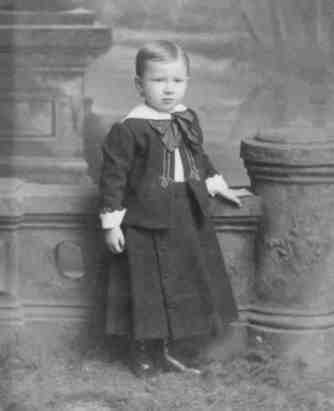
Kilt Suits: Types/Characteristics

Figure 1.--Some boys wore their kilts suits at lengths just above the ankle. This was not a fashion statement, but rather buying a size that the boy could wear for a number of years. Tis may have been his first kilt after having been breeched. Notice the stylish embroidery on the jacket.
|
|
There were considerable variations in kilt/skirt suits popular in the late-19th century. Kilt suits had some of the outward appearances of a Scottish kilt, but in many ways were quite different. Several different garments were used with the kikt suit, including blouses, vests, bodices, vests, and kilt/skirts. The suit varied depending on the actual garments chosen. The most common was a suit-like appearance--kilt suits made with a suit jacket that matched the kilt-sklirt material. Some kilt suits consisted of three pices--ahnd added vest (waistcoat. Other kilt suits consisted of blouses rather than jackets. All the different possible combinations make for quite a variety of different outfit types.
Blouses were worn with some kilt suits. We see boys wearing a variety of blouses with kilt suits.
Some kilt suits were specifically designed to be worn with blouses. Others were not. We nore fancy Fauntleroy blouses worn with some kilt suits. The most obvious were the blouses worn with cut-away jackets, at least the ones worn without vests. With many kilt suits, however, it is difficult to see the type of shirt or blouse being worn. There were some kilt suits designed to be worn with blouses without jackets--sailor blouses. One of the most common was the sailor blouse, in pat of the popularity of the sailor suit by the 1880s. We also note boys wearing blouses without jackets, especially during the summer. Hsre the boys probably had jackets and even vests for their kilt/skirts, but did not wear them in the warm summer weather. The white fancy blouses may have been a summer adaptaion as it would have been uncomfirtably hot to wear the kilt suit jacket.
The jackets of kilt suits came in many different styles. Both single and double breasted styles were commonly worn. Some had decorative braid. While these jackets were fairtly standard, quite a variety of looks were possible because of the different collars that could be worn with the jacket. Some kilt suit jackets appeared with sailor styling, both traditiinal and some with lace trim.
Some kilt suits were bodice garments,
a skirt sewn on to an upper garment and worn with a jacket made of the same material as the kilt skirt. A true kilt of course is a free hanging skirt garment--although bodice kilts were commonly made for the younger boys.
The jackets for kilt suits varied. Some coveredthe entirevchect and buttoned at the chest, sometimes with double breasted style. Others boys wore jackets looking much like modern single breasted jackets with a "V" front center cut. Other jackets were made without the "V" cut of modern jackets. These single jackets were often worn with vests. The vests might have extremely large numbers of buttons. I'm not sure at this time how common the vests were or the different button arrangements. Boys rarely wore their suits with just the vests.
Kilt/skirt Suits
We notice boys wearing both suits that had kilts with kilt styling. Other boys had suits with skirts thazt had no indication of kilt styling, exept perhaps with some kind of plaid material. The skirts or kilt part of kilt suits varied greatly in length. The length was generally longer than actual Highland kilts. Some appear to have been worn at quite long lengths. The lengths were generally from jusy below the knee to almost the ankles. I'm not sure if the length actually followed fashion trends or was just a function of the mother's preferences. Some mothers may have decided on a longer length that the child could wear several years without purchasing a new one.
Some dresses were made to look rather like a kilt suit. These were one piece garments rather than the two- or three- piece kilt suits. These were generally worn by younger boys, although there was some overlap. At times it is not always possible to destinguish kilt-suit drssses from actual kilt suits. Gender is also a factor here. Whikle girls did not normally wear kilt suits, they might wear kilt-suit dresses. We are not entirely sure why a mother would choose a dress that looked like a kilr suit rather than a kilt suit itself. I supose a one-piece garment is easier to put on, simplifying the dressing operaion in the morning. Presumably there are other reasons as well. One aspect of kilt suit dresses is that girls some times sore them while it was relatively rare to see girls wearing actual kilt suits.
HBC

Navigate the Boys' Historical Clothing Web Site:
[Introduction]
[Activities]
[Biographies]
[Chronology]
[Clothing styles]
[Countries]
[Bibliographies]
[Contributions]
[FAQs]
[Glossary]
[Images]
[Links]
[Registration]
[Tools]
[Boys' Clothing Home]
Navigate the Boys' Historical Clothing kilt pages:
[Return to the Main kilt suit design page]
[Return to the Main kilt page]
[Scottish kilts]
[Scottish boys clothing]
[Scottish school uniform]
[Highland dance]
[Irish kilts]
[Irish boys clothing]
[Irish step dancing]
[Greek kilts]
Created: 3:15 AM 1/25/2008
Last updated: 3:15 AM 1/25/2008



